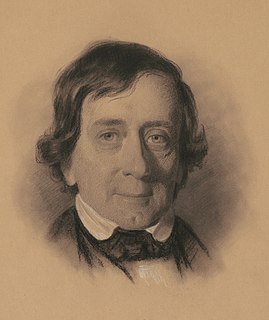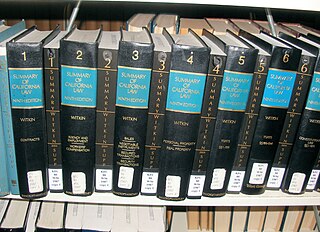The West American Digest System is a system of identifying points of law from reported cases and organizing them by topic and key number. The system was developed by West Publishing to organize the entire body of American law. This extensive taxonomy makes the process of doing case law legal research less time consuming as it directs the researcher to cases that are similar to the legal issue under consideration.

Case citation is a system used by legal professionals to identify past court case decisions, either in series of books called reporters or law reports, or in a neutral style that identifies a decision regardless of where it is reported. Case citations are formatted differently in different jurisdictions, but generally contain the same key information.
Branzburg v. Hayes, 408 U.S. 665 (1972), was a landmark decision of the US Supreme Court invalidating the use of the First Amendment as a defense for reporters summoned to testify before a grand jury. The case was argued February 23, 1972 and decided June 29 of the same year. The reporters lost their case by a vote of 5-4. This case is cited for the rule that in federal courts, a reporter may not generally avoid testifying in a criminal grand jury, and it remains the only case in which the U.S. Supreme Court has considered the use of reporters' privilege.

The Reporter of Decisions of the Supreme Court of the United States is the official charged with editing and publishing the opinions of the Supreme Court of the United States, both when announced and when they are published in permanent bound volumes of the United States Reports. The reporter is responsible for only the contents of the United States Reports issued by the Government Printing Office, first in preliminary prints and later in the final bound volumes. The reporter is not responsible for the editorial content of unofficial reports of the Court's decisions, such as the privately published Supreme Court Reporter and Lawyers' Edition.
Wheaton v. Peters, 33 U.S. 591 (1834), was the first United States Supreme Court ruling on copyright. The case upheld the power of Congress to make a grant of copyright protection subject to conditions and rejected the doctrine of a common law copyright in published works. The Court also declared that there could be no copyright in the Court's own judicial decisions.
The Reporter of Decisions is the official responsible for publishing the decisions of a court. Traditionally, the decisions were published in books known as case reporters or law reports. In recent years, the reporter's duties have been broadened in many jurisdictions to include publication through electronic media.

Law reports or reporters are series of books that contain judicial opinions from a selection of case law decided by courts. When a particular judicial opinion is referenced, the law report series in which the opinion is printed will determine the case citation format.

Richard Peters, Jr. was an American attorney and the fourth reporter of decisions of the Supreme Court of the United States, serving from 1828 to 1843.

The United States Reports are the official record of the Supreme Court of the United States. They include rulings, orders, case tables, in alphabetical order both by the name of the petitioner and by the name of the respondent, and other proceedings. United States Reports, once printed and bound, are the final version of court opinions and cannot be changed. Opinions of the court in each case are prepended with a headnote prepared by the Reporter of Decisions, and any concurring or dissenting opinions are published sequentially. The Court's Publication Office oversees the binding and publication of the volumes of United States Reports, although the actual printing, binding, and publication are performed by private firms under contract with the United States Government Publishing Office.
The Federal Reporter is a case law reporter in the United States that is published by West Publishing and a part of the National Reporter System. It begins with cases decided in 1880; pre-1880 cases were later retroactively compiled by West Publishing into a separate reporter, Federal Cases. The third and current Federal Reporter series publishes decisions of the United States courts of appeals and the United States Court of Federal Claims; prior series had varying scopes that covered decisions of other federal courts as well. Though West is a private company that does not have a legal monopoly over the court opinions it publishes, it has so dominated the industry in the United States that legal professionals, including judges, uniformly cite to the Federal Reporter for included decisions. It is estimated that the Fourth Series of the Federal Reporter will begin sometime around 2025. The United States Reports are the official law reports of the rulings, orders, case tables, and other proceedings of the Supreme Court of the United States.
The Federal Supplement is a case law reporter published by West Publishing in the United States that includes select opinions of the United States district courts, and is part of the National Reporter System. Though West is a private company that does not have a legal monopoly over the court opinions it publishes, it has so dominated the industry in the U.S. that legal professionals uniformly cite the Federal Supplement for included decisions. The Federal Reporter series publishes opinions of the United States Courts of Appeal and the United States Court of Federal Claims; prior series had varying scopes that covered opinions of other federal courts as well. The United States Reports are the official law reports of the rulings, orders, case tables, and other proceedings of the Supreme Court of the United States.

The law of California consists of several levels, including constitutional, statutory, and regulatory law, as well as case law. The California Codes form the general statutory law.
Hewes v. M'Dowell, 1 U.S. 5 (1762) is a decision of a Pennsylvania Provincial Court, issued when Pennsylvania was still an English colony. It is among the first decisions that appear in the first volume of United States Reports.
Lessee of Fothergill v. Fothergill, 1 U.S. 6 (1763) is a decision of the Pennsylvania Provincial Supreme Court, issued when Pennsylvania was still an English colony. It is among the first decisions that appear in the first volume of United States Reports.
The King v. Lukens, 1 U.S. 5 (1762) is a decision of a Pennsylvania Provincial Court, issued when Pennsylvania was still an English colony. It is among the first decisions that appear in the first volume of United States Reports.
Nixon and Harper v. Long and Plumstead, 1 U.S. 6 (1762) is a decision of a Pennsylvania Provincial Court, issued when Pennsylvania was still an English colony. It is among the first decisions that appear in the first volume of United States Reports.
The King v. Haas, 1 U.S. 9 (1764) is a decision of a Pennsylvania provincial court, issued when Pennsylvania was still an English colony. It is among the first decisions that appear in the first volume of United States Reports, and is among the earliest surviving reports of judicial proceedings in North America. It is also one of the first attempts to apply the writ of habeas corpus, then an established principle of English law, in the English colonies that later became the first thirteen states of the United States of America.
The law of Virginia consists of several levels, including constitutional, statutory, regulatory, case law, and local law. The Code of Virginia forms the general statutory law.
The law of Washington consists of several levels, including constitutional, statutory, regulatory and case law, as well as local ordinances. The Revised Code of Washington forms the general statutory law.



